ARCH: A Visual Language of Interpersonal Interactions and Collaborative Project Engagement

The ARCH Framework and More
The ARCH Framework is a framework for curating several models for Interpersonal Interactions and Collaborative Project Engagement.
What's Collaborative Project Engagement?
In Jan 2021, I wrote a book (draft) titled Project-oriented Activity Theory to introduce Andy Blunden's approach to “An Interdisciplinary Theory of Activity”.

In order to develop the notion of “Project as a unit of Activity” as a theoretical foundation of the new interdisciplinary theory of Activity, Blunden adopts Hegel’s logic and Vygotsky’s theory about “Unit of Analysis” and “Concept” as theoretical resources. The process is documented in four books:
- An Interdisciplinary Theory of Activity (2010)
- Concepts: A Critical Approach (2012)
- Collaborative Projects: An Interdisciplinary Study (2014)
- Hegel for Social Movements (2019)
Blunden also gives an archetypal unit of a project in his 2010 book An Interdisciplinary Theory of Activity:
"Two people working together on a common project"

He says, “The rich context of the notion of collaboration also brings to light more complex relationships. The notions of hierarchy, command, division of labor, cooperation, exchange, service, attribution, exploitation, dependence, solidarity, and more can all be studied in the context of just two individuals working together on a common project. And yet almost all the mysteries of social science as well as a good part of psychology are contained in this archetypal unit: two people working together in a common project.” (2010, p.315)
What Blunden suggested are that 1) We can use “Project” as a new unit of analysis for Activity Theory, 2) Project should be understood as formulation of concept, and 3) The archetypal unit of “Project” is two people working together in a common project.
How can two people work together on a common project?
How does it happen?
The notion of "Collaborative Project Engagement" aims to answer this question and develop a framework and a toolkit.
The ARCH Framework is a conceptual combination because I curate several models together.
The Basic Model
The following diagram is the basic model of the ARCH framework.
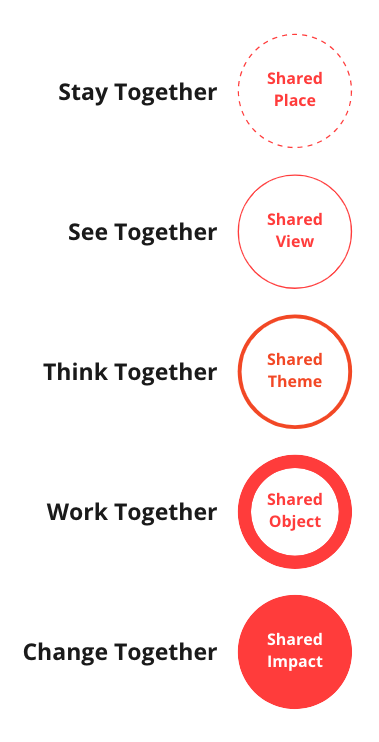
This five-stage schema is inspired by the Attachance Framework.
The Basic Diagram
The ARCH diagram was born from my research project about social (interaction) design in 2017. Later, I realized that it can be used for discussing conflict, consensus, and intersubjectivity in general. See the diagram below.

In 2020, I used the ARCH diagram to curate Alan P. Fiske's Relational Models Theory and Clay Spinuzzi’s typology of Activity. See the diagram below. You can find more details in The ARCH Diagram.
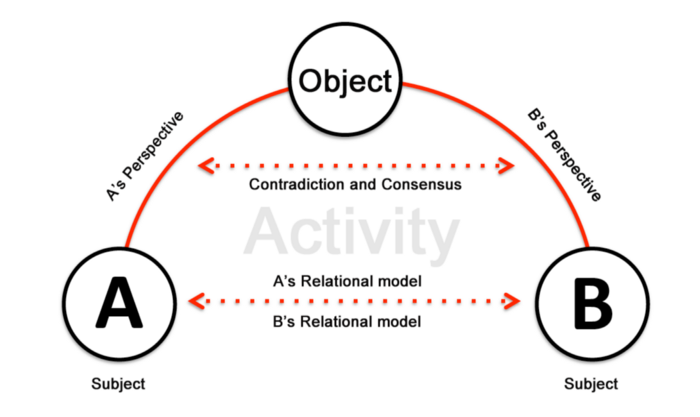
Ten days ago, I used the ARCH diagram to discuss the Activity Analysis Intervention program. See the diagram below.

The original version of ARCH model only considers Contradiction and Consensus. This case study expands its object to Synergy Effects. You can find more details in The ARCH of Synergy Effects.
I also found the ARCH diagram is a useful visual format for discussing intersubjectivity.
This means I can develop a visual language for knowledge curation about interpersonal interactions and intersubjectivity in general.
We can start with Collaborative Project Engagement!
Stay Together: Shared Place
The first stage is Stay Together and its keyword is Openness. See the diagram below.
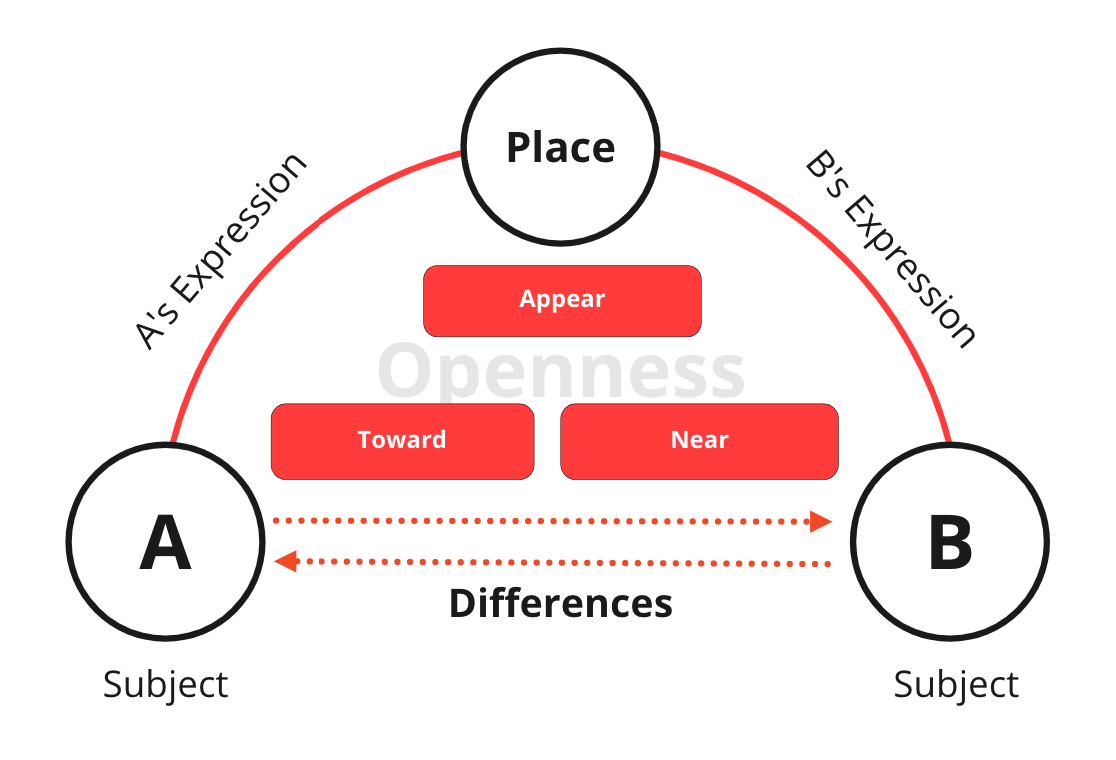
There is a framework called "Ecological Zone" behind the above diagram. I only use the ARCH diagram to highlight several key ideas of the "Ecological Zone" framework.
In 2018, I developed the Ecological Zone framework to highlight a new theoretical creative space for an ecological approach to social interaction. The term "Ecological Zone" refers to an interactive space between two subjects with a shared activity in a short duration or long duration. See the diagram below.

One ecological aspect of the Ecological Zone framework is “Ecological Force”. The term “Force” is inspired by Lewin’s topological psychology. However, my term “Ecological Force” highlights the source of force. I pay attention to the ecological source of force. For instance, the above diagram displays two signs:
- - Da
- - Db
D refers to Distance which is claimed to be an ecological force from the perspective of the Ecological Zone. Distance is a fact that exists due to two people. If there is only one person, there is no Distance. The fact of Distance doesn’t depend on any person of the two people but on their relative positions.
Let’s say the shard activity is a project of remote work in which Distance is a solid ecological force. Person A perceives a negative impact of remote work due to the Distance. This experience is represented by the sign “-Da”. In like manner, I use the sign “-Db” to represent a negative impact perceived by person B.
Due to the individual difference, person B may perceive a positive impact caused by Distance from the project of remote work. Furthermore, Distance is only one type of ecological force, there are many types of ecological forces in different types of activities.
I have to emphasize that the above "Share Place" diagram is not a direct application of the "Ecological Zone" framework. The "Share Place" diagram considers Differences, Share Places, and Expressions. Moreover, the "Share Place" diagram highlights the change of distance between A and B: Appear, Toward, and Near.
See Together: Shared View
The second stage is See Together and its keyword is Opportunity. See the diagram below.
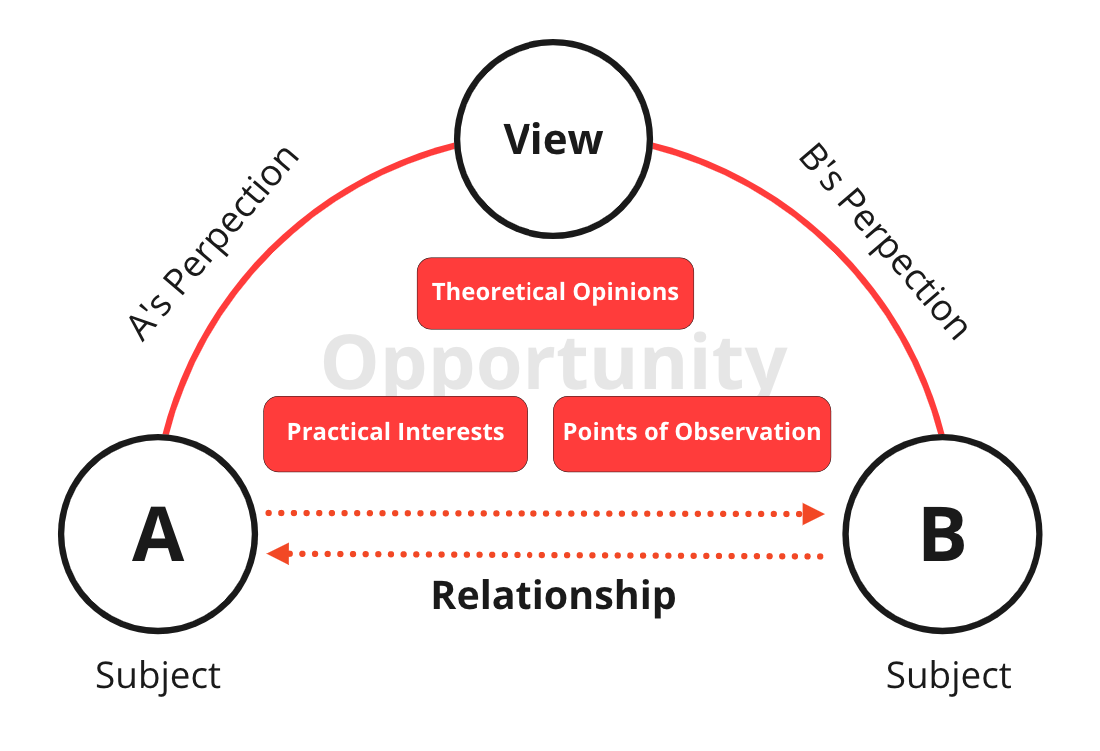
I use the Ecological Perspective Framework to support the above diagram.

You can find more details in Life Discovery: “Points of Observation” and “Significant Insights”.
Think Together: Shared Theme
The third stage is Think Together and its keyword is Relevance. See the diagram below.
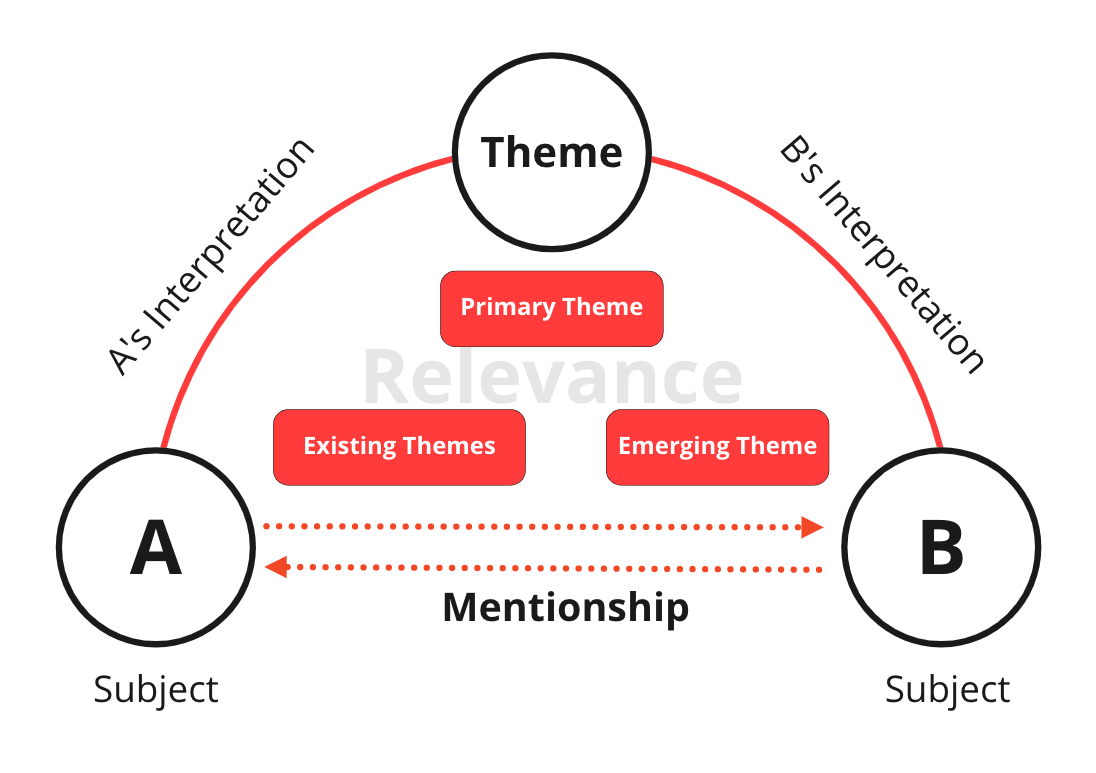
The primary theoretical resource behind the above diagram is "Themes of Practice". You can find more details in Themes of Practice (2019–2021).
In July 2021, I conducted an empirical study titled Themes of Practice, Social Media, and Interpersonal Communication and wrote a 56-page report. Some ideas are adopted for the present model:
- Primary Theme
- Existing Themes and Emerging Themes
- Interpretation
- Mentionship
I also consider Relevance Theory as a theoretical background.
Work Together: Shared Object
The fourth stage is Work Together and its keyword is Activity. See the diagram below.
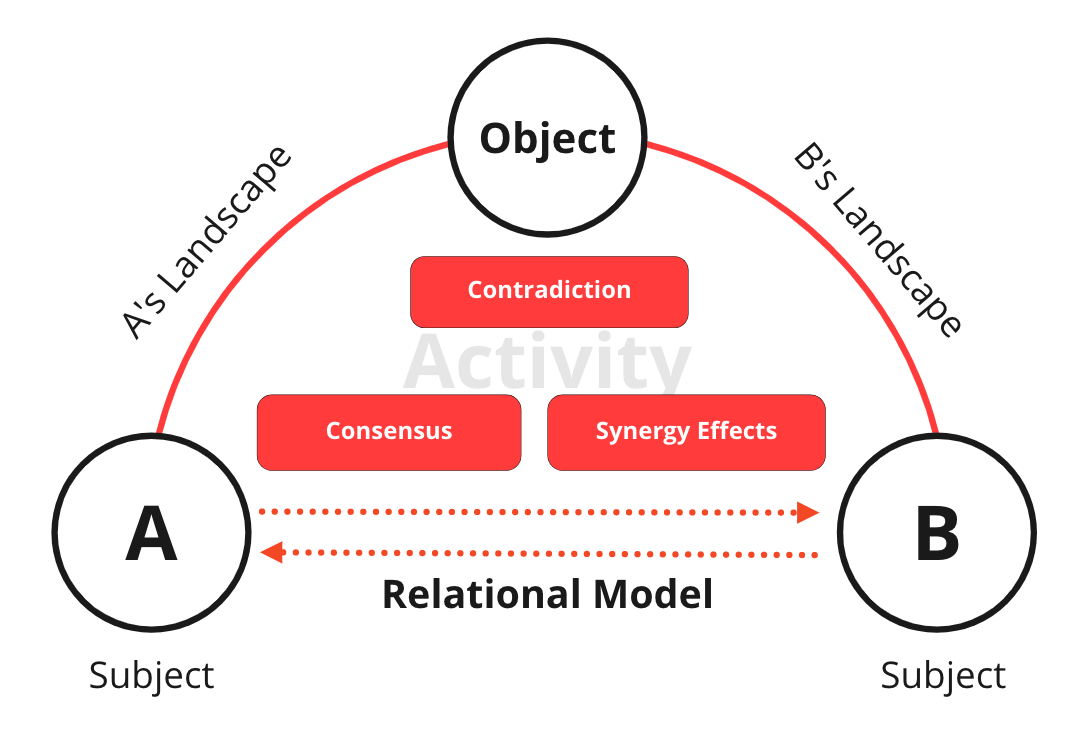
There are two theoretical resources behind the above diagram: Alan P. Fiske's Relational Models Theory and Clay Spinuzzi’s typology of Activity. You can find more details in The ARCH Diagram.
This is the original ARCH model. I only modify the visual style.
Change Together: Shared Impact
The fifth stage is Change Together and its keyword is Achievement. See the diagram below.
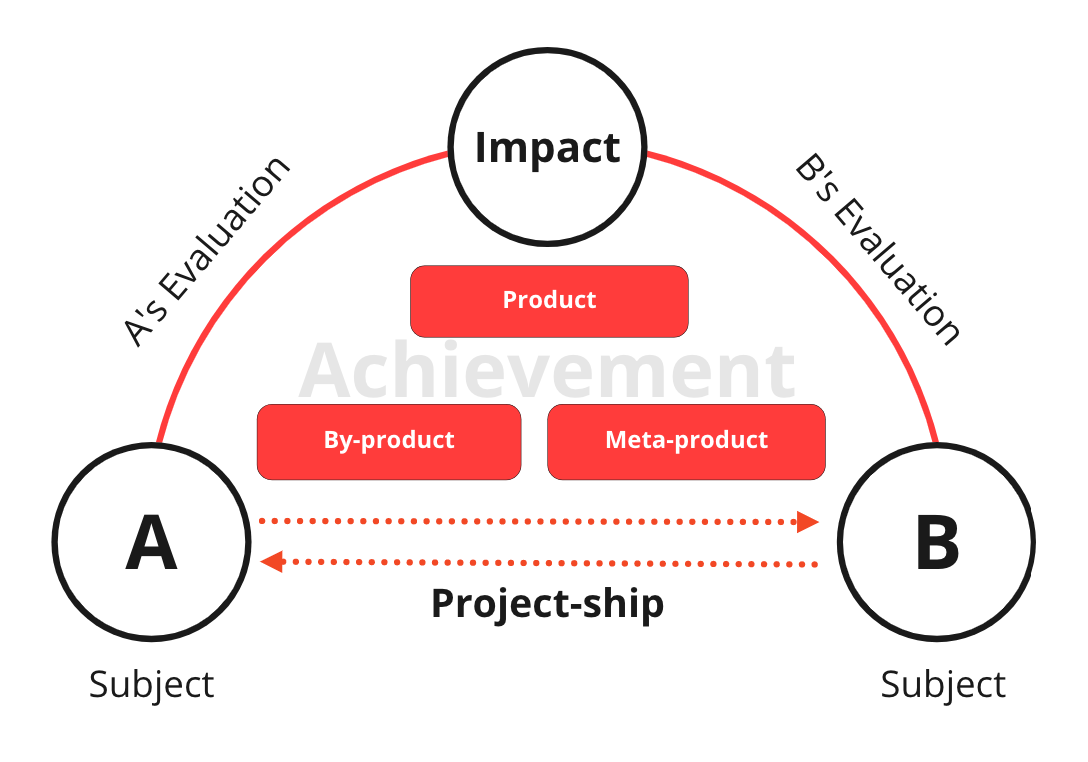
The above diagram is inspired by the Achievement Chain diagram which is part of the Life-as-Activity framework (v0.3). See the diagram below.

The above "Shared Impact" diagram only emphasizes Product, By-product, and Meta-product. You can find more details in Life-to-be-Owned: The Achievement Chain.
The ARCH Visual Language for Intersubjective Design
The ARCH Framework is developed for practitioners, so I only highlight some key ideas of each framework. You don't have to learn all frameworks.
The next step is developing a playbook for the ARCH framework. All key ideas will be transformed into actionable knowledge for practitioners.
Moreover, I see the ARCH Framework as a new visual language for discussing Interpersonal Interactions.
For the Collaborative Project Engagement Toolkit, I use the five-stage schema to curate several frameworks. For other topics of interpersonal interactions and intersubjectivity in general, we can use other schemas as meta-frameworks.
We can use the ARCH diagram as the primary knowledge container to contain related theoretical resources and frameworks.
The above Collaborative Project Engagement toolkit is the exemplar of the ARCH Visual Language for Intersubjective Design.
